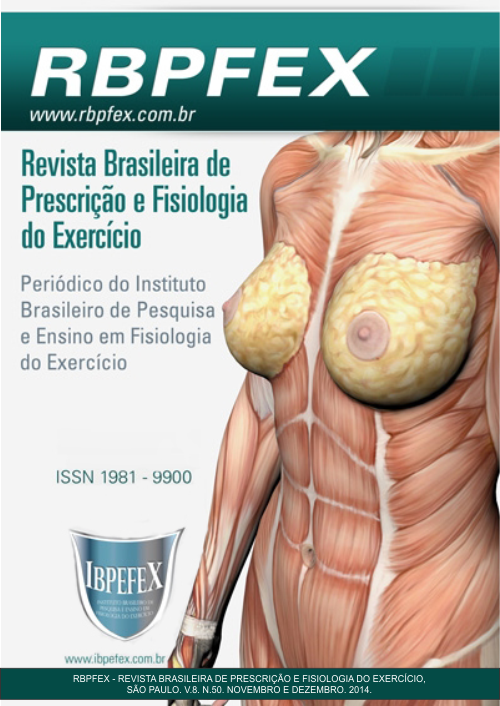Effect of hip joint flexibility training on vertical jump in young female volleyball athletes
Abstract
Aim: To investigate the effect of different training protocols (with and without flexibility training) in flexion and hip extension and its effects on their vertical jump. Materials and Methods: The study included 48 volleyball athletes female, aged 11 to 17 years, divided into four groups: The "Children" (n=12); B "Child" (n=12); C "Youth" (n=12) and D "Youth" (n=12). Body mass, stature was evaluated, and subsequently calculated the Body Mass Index (BMI). Then calculate the percentage of fat. Flexibility was assessed using the Wells Bench and fleximeter. The counter-movement vertical jump was measured using a pressure platform and analyzed with the Jump Test 2.0 software. Results: After intervention with flexibility training, there was improvement in height (pre: 21.8±1.2 cm, post: 24.0±1.4 cm,p=0.03) and vertical jump power in group A (pre: 296.0±17.2 W/kg, post: 317.5±13.1 W/kg, p=0.03). Increased flexibility in the C group (pre: 27.2±1.2 cm, post: 29.5±1.4 cm, p=0.03). Improvement in height (pre: 19.4±1.7 cm, post: 21.5±1.5 cm, p=0.04) and vertical jump power in group B (pre: 213.8±11.6 W/kg, post: 226.0±9.7 W/kg, p=0.04). Conclusion: After the 12-week intervention with passive stretching method there was an increase and/or maintaining flexibility, vertical jump (cm) and power (W/kg) in female athletes.
References
-Asher, C. Variações de postura na criança. São Paulo: Manole. 1976.
-Bandy, W.D.; Irion, J.M.; Briggler, M. The effect of time and frequency of static stretching on flexibility of the hamstring muscles. PhysTher. Vol. 77. Num. 10. 1997. p. 1090-6.
-Barbanti, J.V. Teoria e prática do treinamento esportivo. 2ª edição. Edgard Blücher. 1997.
-Bosco, C.; Luthtanen, P.; KomI, P.V.A. Simple method for measurement of mechanical power in jumping. European Journalof Applied Physiology and Occupation Physiology. Vol. 50. Num. 2. 1983. p. 273-282.
-Bosco, C.; Viitasalo, J.T.; Komi, P.V.; Luhtanen, P. Combined effect of elastic energy and myoeletriccal potentiation during stretch-shortening cycle exercise. Acta Physiologica Scandinavica. Vol. 114. Num. 4. 1982. p. 557-565.
-Coledam, D.H.C.; Arruda, G.A.; Oliveira, A.R. Efeitos de um programa de exercícios no desempenho de crianças nos testes de flexibilidade e impulsão vertical. Motriz, Rio Claro. Vol. 18. Num. 3. 2012. p. 515-525.
-Dias, R.M.; Cyrino, E.S.; Salvador, E.P. Impacto de oito semanas de treinamento com pesos sobre a força muscular de homens e mulheres, Revista Brasileira de Medicina e Esporte. Vol. 11. Num. 4. 2005. p. 224-228.
-Guedes, D.P. Composição corporal: princípios, técnicas e aplicações. Manole. 1994.
-Guedes, D.P.; Guedes, J.E.R.P. Manual prático para avaliação em educação física.Manole. 2006.
-Gobbi, S.; Villar, R.; Zago, A.S. Bases Teóricas-práticas do condicionamento físico.Guanabara Koogan. 2005.
-Grahame, R. Joint hipermobility and genetic collagen disorders: are they related? Arch Dis Child. Vol. 80. Num. 2. 1999. p. 188-91.
-Guissard, N.; Duchateau, J. Neural aspects of muscle stretching. Exerc Sport Sci Rev. Vol. 34. Num. 4. 2006. p. 154-8.
-Hinman, M.R. Comparison of thoracic kyphosis and postural stiffness in younger and older women. Spine J. Vol. 4. Num. 4. 2004. p. 413-7.
-Lamari, N.; Marino, L.; Cordeiro, J.; Pellegrini, A.M. Flexibilidade anterior do tronco no adolescente após o pico da velocidade decrescimento em estatura. Acta Ortopédica Brasileira. Vol. 15. Num. 1. 2007. p. 25-29.
-Machado, D.R.L.; Bonfim, M.R.; Costa, R.T. Pico de velocidade de crescimento como alternativa para classificação maturacional associada ao desempenho motor. Revista Brasileira de Cineantropometria e Desempenho Humano. Vol. 11. Num. 1. 2009. p. 14-21.
-Mikkelson, L.O.; Nupponen, H.; Kaprio, J.; Kautiainen, H.; Mikkelson, M.; Kujala, U.M. Adolescent flexibility, endurance strength, and physical activity as predictors of adult tension neck, low-back pain, and knee injury: a 25-year follow up study. Br J Sports Med. Vol. 40. Num. 2. 2006. p. 107-13.
-Nogueira, C.J.; Galdino, L.A.S.; Vale, R.G.S.; Dantas, E.H.M. Efeito agudo do alongamento submáximo e do método de Facilitação Neuromuscular Proprioceptiva sobre a força explosiva. HU Revista, Juiz de Fora. Vol. 35. Num. 1. 2009. p. 43-48.
-Oliveira, A.L.; Nogueira, N. Influência do stretching global activo na flexibilidade da cadeia posterior e no salto vertical no voleibol. Revista Portuguesa de Fisioterapia no Desporto. Vol. 2. Num. 2. 2008. p. 7-17.
-Organização Pan-Americana da Saúde, Organização Mundial da Saúde. 26ª Conferência Sanitária Pan-Americana. Washington.23-27 de setembro de 2002. Disponível em: .
-Platonov, V.N.; Bulatova, M.M. A preparação física. Sprint. 2003.
-Reid, D.A.; McNair, P.J. Passive force, angle, and stiffness changes after stretching of hamstring muscles. Medicine and Science in Sports and Exercise. Vol. 36. Num. 11. 2004. p. 1944-1948.
-Silva, L.R.R.; Böhme, M.T.S; Uezu, R.; Massa, M. A utilização de variáveis cineantropométricas no processo de detecção, seleção e promoção de talentos no voleibol. Revista Brasileira de Ciência & Movimento. Vol. 11. Num. 1. 2003. p. 69-76.
-Siri, S.E. Body composition from fluid spaces and density: analysis of methods. In: Brozek, J.; Henschel, A.; editores. Techniques for Measuring Body Composition. Washington.National Research Council.1961. p. 223.
Authors who publish in this journal agree to the following terms:
- Authors retain the copyright and grant the journal the right of first publication, with work simultaneously licensed under the Creative Commons Attribution License BY-NC which allows the sharing of the work with acknowledgment of the authorship of the work and initial publication in this journal.
- Authors are authorized to enter into additional contracts separately for non-exclusive distribution of the version of the work published in this journal (eg, publishing in institutional repository or book chapter), with acknowledgment of authorship and initial publication in this journal.
- Authors are allowed and encouraged to post and distribute their work online (eg, in institutional repositories or on their personal page) at any point before or during the editorial process, as this can bring about productive change as well as increase impact and impact. citation of published work (See The Effect of Free Access).






